effectiveness of treatmentback paindirectly depends on how accurately it was delivereddiagnosis. . . However, the pain syndrome itself is not some specific symptom - it is a general symptom, according to which it is impossible to establish the cause of the disease. There are many different pathologies that can causeback pain, and not all of them are associated with diseases of the musculoskeletal system.
When self-medicating, patients mistakenly believe that coping with pain is the most important thing, and they forget the fact that every pain has a cause. Taking painkillers is a symptomatic treatment that works for neither disease. affects the outcome and not the cause of the pain.
Main causes of back pain
consider the mainDiseasebecause ofback pain. . . For the convenience of diagnosis, doctors divide the back into upper (cervical spine), middle (thoracic spine), and lower (lumbosacral) parts.
upper back pain
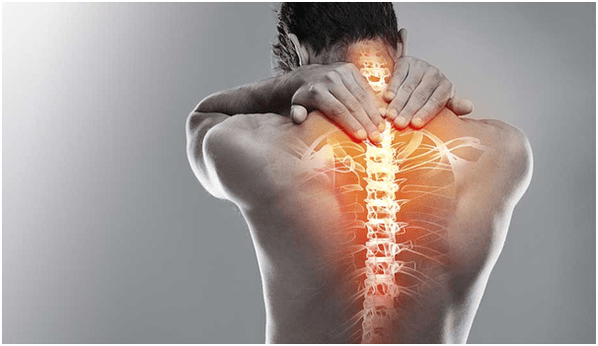
Pain in the cervical spine requires extreme attention. The reason lies in the unique anatomical features of the cervical vertebrae: the vertebral artery passes through them, supplying blood to the brain; The first and second cervical vertebrae form a movable complex joint with the skull, which is responsible for turning and tilting the head; Any disease that occurs at this stage has the potential to cause severe neurological damage, as damage or even minor compression of the spinal cord in the cervical spine immediately leads to impaired motor and/or sensory function throughout the body.
osteochondrosis of the cervical spine
Normally, the intervertebral discs, joints, ligaments and tendons do not have their own blood vessels; Their blood supply depends on how intensely blood is supplied to the surrounding muscles and bones. If this process is disrupted, for example, offices leading a sedentary and sedentary lifestyleIn the employee, degenerative-dystrophic changes begin in them. The nutrition of the cartilage of the intervertebral discs and joints is impaired, the ligaments and tendons thicken, the spinal canal narrows due to sclerotic changes and between the vertebraedistance decreases.
Among non-specialists, this disease is known as spinal osteochondrosis. Despite the fact that degenerative-dystrophic processes are characteristic of the entire spine, it is osteochondrosis that is the most common cause of pain in the cervical spine. In addition, the spineAs in other parts of the U. S. , this disease can be complicated by an intervertebral hernia. However, due to the peculiarities of the anatomy of the cervical spine, even a small hernia can cause serious complications.
shock
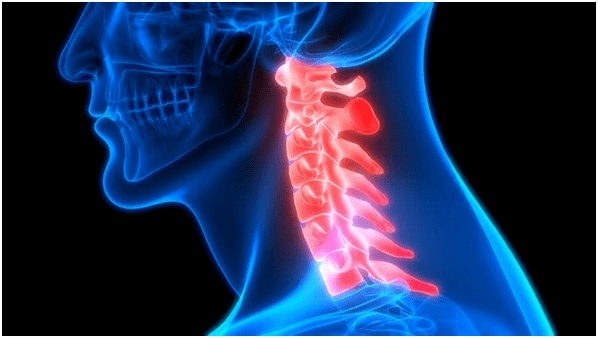
Although spinal cord injury is usually diagnosed in the lumbar spine, trauma to the cervical spine accounts for approximately 50% of spinal cord injury. This is due to the peculiarities of the anatomy of the neck: aThe absence of a developed muscular frame and large vertebral bodies, high mobility contribute to trauma even without direct physical impact (for example, a sudden stop or a blow from behind during an accident, the so-called whiplash injury of the neck often occurs, which occurs due to the sharp extension of the cervical spine after a sharp bending). Pain is a constant companion of any spinal cord injury.
myositis
Myositis or inflammatory muscle diseases are a whole group of diseases characterized by muscle pain. The most common cause of inflammation of the banana muscles when performing any work, hypothermia, drafts is a forced posture. Muscle pain in the cervical spine, intervertebral herniaMay result in osteochondrosis of the neck - the muscles take most of the load on the neck, which eventually leads to muscle spasms with overstrain, impaired microcirculation and inflammation.
neuralgia
Neuralgia is a condition in which nerve fibers themselves become the source of continuous pain impulses. The pain is paroxysmal, may be sharp and aggravated by turning or tilting the head, in cold weather. The cause of neuralgia is associated with diseases of the spine -Osteochondrosis, intervertebral hernia, scoliosis, etc. The immediate cause of pain is irritation of the spinal roots when they are pinched in the intervertebral space, muscle spasm, which disrupts the metabolism in the nerves passing through the spasm musclesWith neuralgia, unlike neuritis or inflammation of the nerve, the pain is periodic, there are no pathological changes in the nerve fibers themselves.
heart diseases
Heart diseases such as angina pectoris, ischemic heart disease, atherosclerosis of coronary vessels are often accompanied by pain in the neck, lower jaw, shoulder and left forearm. Numbness with pain, tingling on the skin, osteochondrosis of the cervical spine with intervertebral herniaMay have simulating pain. Often, patients receive massage, physiotherapy, go to other doctors, although an electrocardiogram is enough to diagnose the cause.
A distinctive feature of this type of pain is the ability of antianginal drugs that improve blood flow through the coronary arteries (isocet, nitroglycerin) to relieve pain within a few minutes.
middle back pain
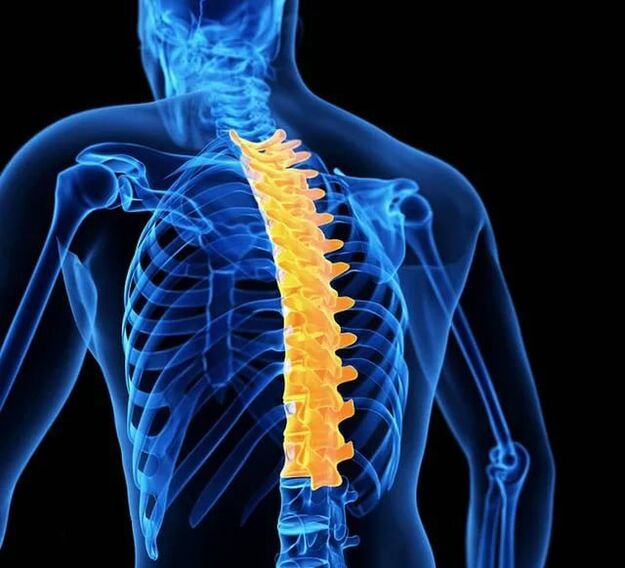
The thoracic spine consists of 12 thoracic vertebrae, each of which has a pair of ribs attached to it. Together they provide protection to the chest organs. The thoracic vertebrae gradually increase in size, starting with 1 thoracic vertebra, to the lumbarto the beginning of the spine - this is explained by a gradual increase in the load on them. The mobility of the middle back is much less than the mobility of the neck, the ribs provide additional protection, which is why the spine in the thoracic spineTraumatic damage to the bone is less common.
spinal curvature or scoliosis
Scoliosis or scoliotic disease is a pathological curvature of the spine in several planes. The causes of scoliosis are still not well understood, the disease begins in childhood. Lack of physical activity, weakness of the back muscles, Improper posture and organization of the workplace of schoolchildren are considered contributing factors. Due to the pronounced curvature, impaired distribution of loads and biomechanics of the spine, overstretching of the muscles that compensate for part of the load,get uplong termback pain.
Arthritis (spondyloarthritis)
Intervertebral joints, together with the intervertebral discs, connect the spine into a single whole. Each vertebra has 4 articular surfaces that form joints with adjacent vertebrae. Like any other joint, the intervertebral joints can become inflamed. This diseaseThe related condition is called spondyloarthritis. There are two main causes of inflammation of the intervertebral joints. These are systemic rheumatic diseases (such as rheumatoid arthritis or ankylosing spondylitis) or reactive inflammation in response to increased loads in osteochondrosis, scoliosis and other spinal deformitiesOccurs. Inflamed joints lose their function: stiffness of movements, stiffness of the spine, Prolonged back pain.
Diseases of the gastrointestinal tract and back pain
Diseases of the abdominal organs are often the cause of pain reflected in the back and spine. There is also a direct relationship between pathologies of the gastrointestinal tract and diseases of the musculoskeletal system. Diseases such as chronic colitis or gastroenteritis are the background of spondyloarthritis or osteochondrosis of the spine.
Most often, pain reflected back pain accompanies gastric ulcer and duodenal ulcer, with hiatal hernia, acute or chronic pancreatitis. This phenomenon arises from the peculiarities of the sympathetic and parasympathetic systems, the nerve fibers of which are located in each of the abdominal cavity. are present in the limb. Part of the pain impulses experienced by them travels back to the spinal cord roots, simulating pain in the spine and back.
kidney disease and back pain
The kidney is a paired organ located in the retroperitoneal space, which, in the case of the abdominal organs, is closely associated with nerves with the roots of the spinal cord. In the presence of inflammation, stones or other pathologies of the urinary tract, the transmission of pain impulsesThe part reaches the spinal cord, simulating a disease of the spine.back pain symptomsAcute pyelonephritis, renal colic, may occur with renal abscess. A typical symptom is tension of the back muscles in the projection of the kidneys, caused by inflammation of the kidneys or abscess of the tissue surrounding them.
lumbosacral spine pain
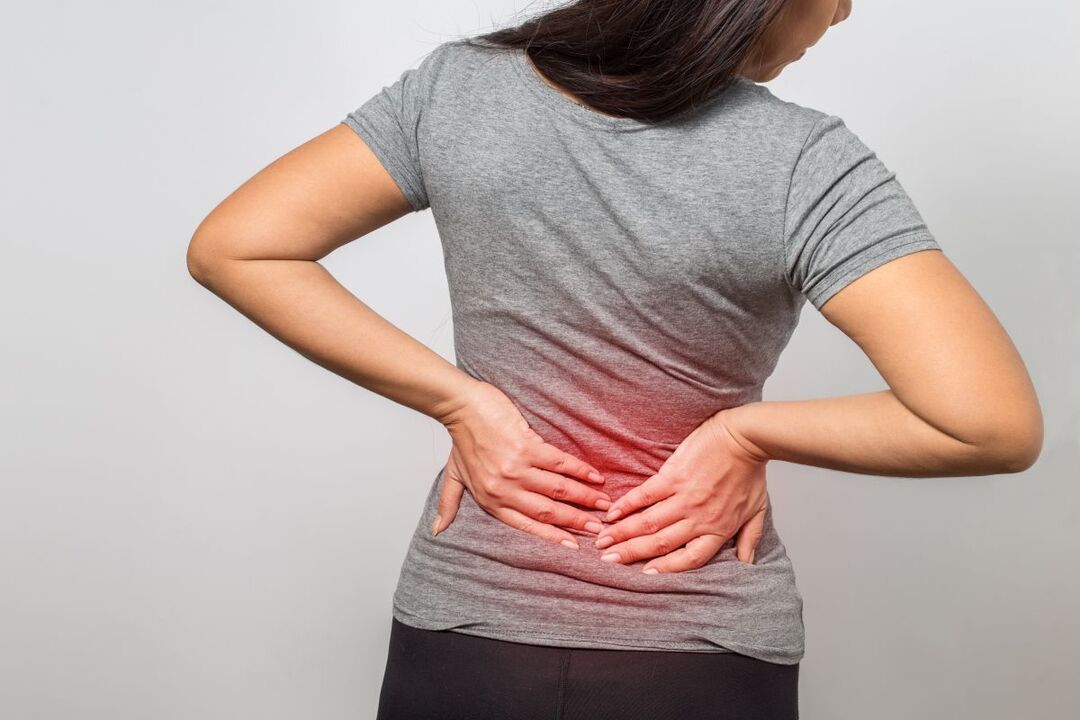
The most stress occurs in the lumbosacral spine. 60-70% of the adult population of developed countries complains of back pain. This is the preferred localization of intervertebral hernias. A patient is often diagnosed with 2-3 hernias in the lumbosacral spine. In addition, pain in the lower back and sacrum often accompanies gynecological and urological pathologies.
intervertebral hernia
An intervertebral hernia is the result of long-term osteochondrosis of the spine. While in the cervical region, relatively small loads are placed on the intervertebral discs, in the lumbosacral region, there is excessive pressure on each disc. Any weight due to a healthy disc semi-fluid coreHowever, due to osteochondrosis, the fibrous and strong cartilage (annulus fibrosus) running along the periphery of the intervertebral disc loses its elasticity and strength, and itsSome parts may crack. With a sharp increase in load, for example, when lifting weights, the pressure inside the diseased disc increases, because of which its contents can actually "shoot" through the damaged cartilage, the spinefalls into the lumen of the bone canal - thus an intervertebral hernia is formed.
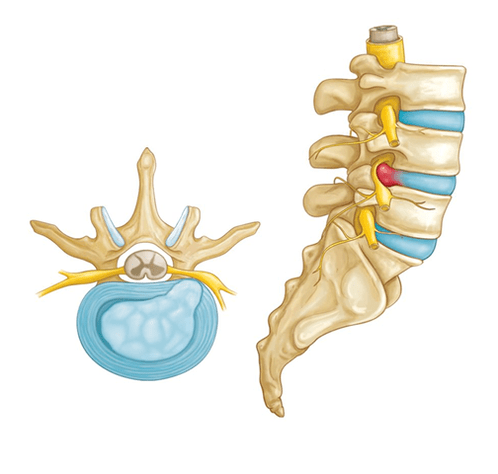
Fragments of the nucleus that have fallen off the discs compress the spinal cord and spinal roots. As a result, there is inflammation of the nervous tissues and impaired blood circulation, which is accompanied by severe pain and spasm of the protective muscles. The pain may be unbearable. May occur, up to the need for the use of narcotic analgesics. A distinctive feature is radiating pain into the lower extremities. There may be decreased sensitivity to pain, tingling and numbness of the skin of the lower leg and thigh.
intervertebral disc protrusion
The main difference between protrusion of an intervertebral disc and a hernia is the preservation of the integrity of the annulus fibrosus. The cause of pain is the compression of the spinal cord and its roots by the protrusion along the periphery of the intervertebral disc. However, if the process continues, thenProtrusion can easily turn into a hernia. Symptoms and pain are similar to those of a herniated disc, as the severity of the pain syndrome depends not only on the size, but also on the location of the protrusion or hernia.
spondylosis of the spine
Excessive load and degenerative-dystrophic processes in the spine can lead to ossification of cartilaginous tissue, which is saturated with calcium salts and turns into protrusions or growths of sharp coracoid bone arising along the periphery of the vertebral bodies. Progression of the processWith S. , these growths may merge with similar growths on the bodies of adjacent vertebrae. Over time, all vertebrae grow together, the spine loses its flexibility and elasticity. Pain irritating, reactive, in the spinal cord and its rootsInflammation is caused by dystrophy of the soft tissues, ligaments and muscles surrounding the spine.
radiculitis
Radiculitis is called acute pain arising from circulatory disorders and ischemia of the spinal roots, strangulated by hernia or protrusion with osteochondrosis of the spine. regions of the buttocks, perineum, thighs and lower legsVarious disorders of skin sensitivity are possible inThis condition is called sciatica or sciatica.
spinal cord infection
Vertebrates are composed of spongy bone tissue rich in bone marrow. When an infection enters the body of the vertebrate into the bloodstream, an inflammatory process can occur - osteomyelitis. The gradual decay of bone tissue is accompanied by necrosis - this pictureAlso typical for tuberculosis of the spinal cord. Pain can be caused by irritation of nerve endings, and due to pathological compression fractures of the spinal cord, weakened by inflammation.
gynecology and urological diseases
Pathologies such as cervical cancer, endometriosis or adnexitis (inflammation of the uterine appendages) in women, prostatitis or prostate cancer in men are often accompanied by severe pain in the lumbosacral spine. The nature of the pain is characterized by irritation of the nerves caught in the area of inflammation, or tumorsis explained by the development of nerve trunks.
back muscle pain along the spine
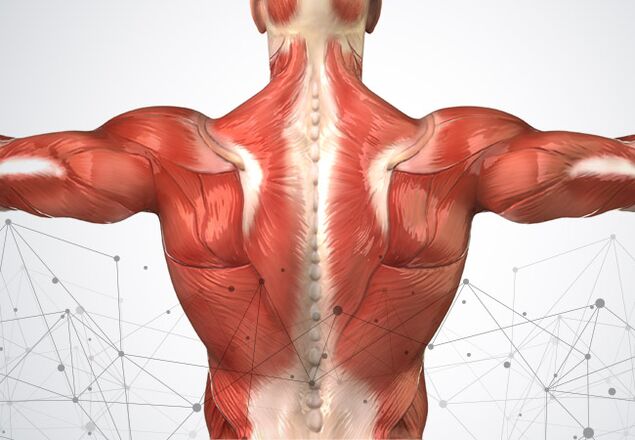
Well developed back muscles are a sign of a healthy spine, as the muscular corset relieves some of the tension and additionally stabilizes the spine. In chronic diseases of the spine, the muscles are subjected to excessive loads, which weakenAnd atrophied muscles are not able to bear. As a result, muscle spasms occur, and due to metabolic disorders in the muscles and pain. This condition is called myofascial syndrome, characterized by osteochondrosis of the spine, hernias and protrusions of the intervertebral discsfeature of.
postoperative pain
Spine surgery is usually accompanied by extensive trauma – to stabilize and restore vertebral integrity, doctors may resort to installing metal structures, tightening screws into the vertebrae, and removing non-viable tissue. Pain is caused not only by disease, but also by surgery. With proper rehabilitation and postoperative care, the pain will gradually disappear. However, if in the postoperative period you neglect the instructions of doctors andIf obligatory exercises are neglected, the pain can become chronic.
How are the causes of back pain diagnosed?
Diagnosing back and spinal pain requires timely medical help from a qualified neurologist. In the first stage, a neurological examination, a patient survey, a study of reflexes and symptoms are performed. An experienced and competent physicianKnows well what diseases the pain in the back and spine have for certain causes and specific features.
Back pain for no apparent reason should be especially alert. It can occur with tumors and diseases of the spinal cord, with reflected pain of other organs and systems.
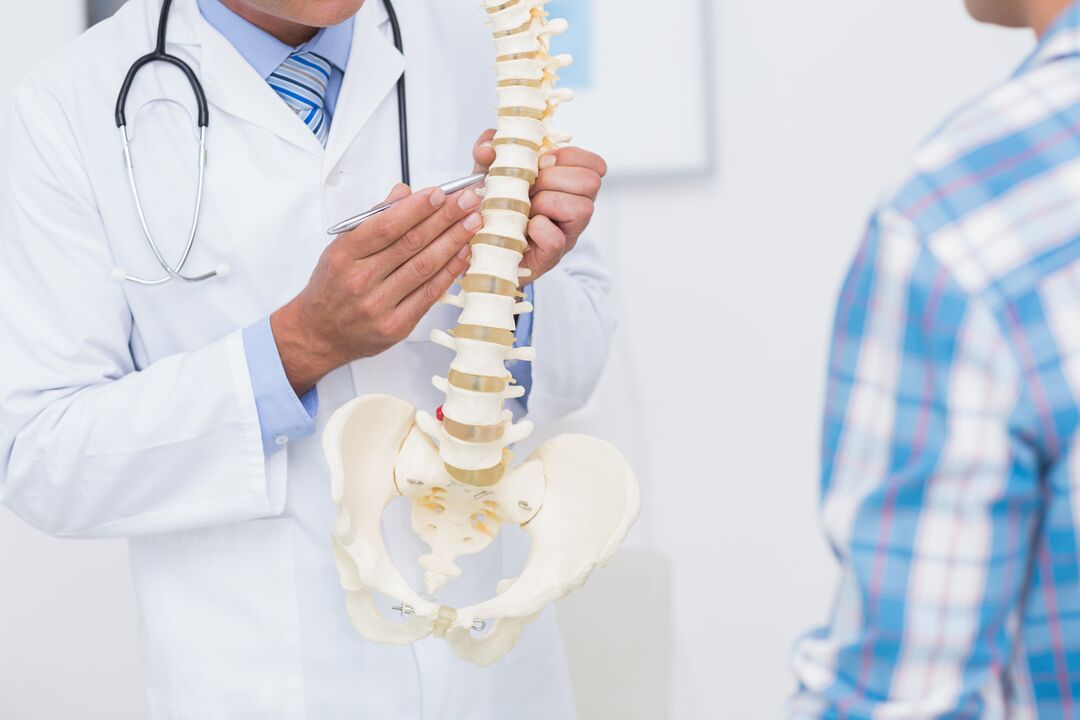
To find out why the back and spine hurt, a neuropathologist may prescribe magnetic resonance imaging. This is the most effective and safe way to diagnose almost all possible causes of back pain. Based on the ability of magnetic fields and radio waves to give clear and detailed images of the spine and spinal cord without the use of other damaging factors.
how to relieve back pain
In order to get rid of back pain, but not cure, let us take analgesics for several days, for which it is necessary to wait for a consultation with a specialist. Often, non-steroidal anti-inflammatory drugs or NSAIDs are used for this purpose. However, it is important to remember that this group of drugs can cause dangerous side effects, the likelihood of which increases with prolonged use. It is therefore important that a doctor's visit and examination be carried out for laterDo not postponeTreatmentdiseasesspinal cordmore reasonback pain.
spine pain treatment
As stated at the outset, the effectiveness of back pain treatment depends on how accurately the diagnosis was made. Despite the obvious, many patients "treat" the pain for years, but on their own. Not a disease, avoiding a visit to the doctor every time, turn to traditional healers, osteopaths and chiropractors. In addition, for some diseases of the spine, such procedures are not only contraindicated, but also dangerous.
There are effective and scientifically proven treatments for variousspeciesdisease causingback pain. . . Many of these require the patient's perseverance and perseverance in the fight against the disease. It is important to remember that there are no pills or injections to treat osteochondrosis - only you can do this, training hardAnd with physical exercises that a neurologist will show you.
Which doctor should I contact for spine pain?
Back pain is one of the most common neurological symptoms that occurs due to the involvement of the nerves and spinal cord in the pathological process. Therefore, the first specialist whose consultation is necessary to obtain in case of pain in the spine will be a neurologist. ExaminationDepending on the results of K and magnetic resonance imaging, you may need to consult another doctor. If the back pain is due to heart disease, the patient is referred to a cardiologist if the problem lies in the digestive system. If it is referred to a gastroenterologist. But most often the pain syndrome is associated with a pathology of the spine.

















































